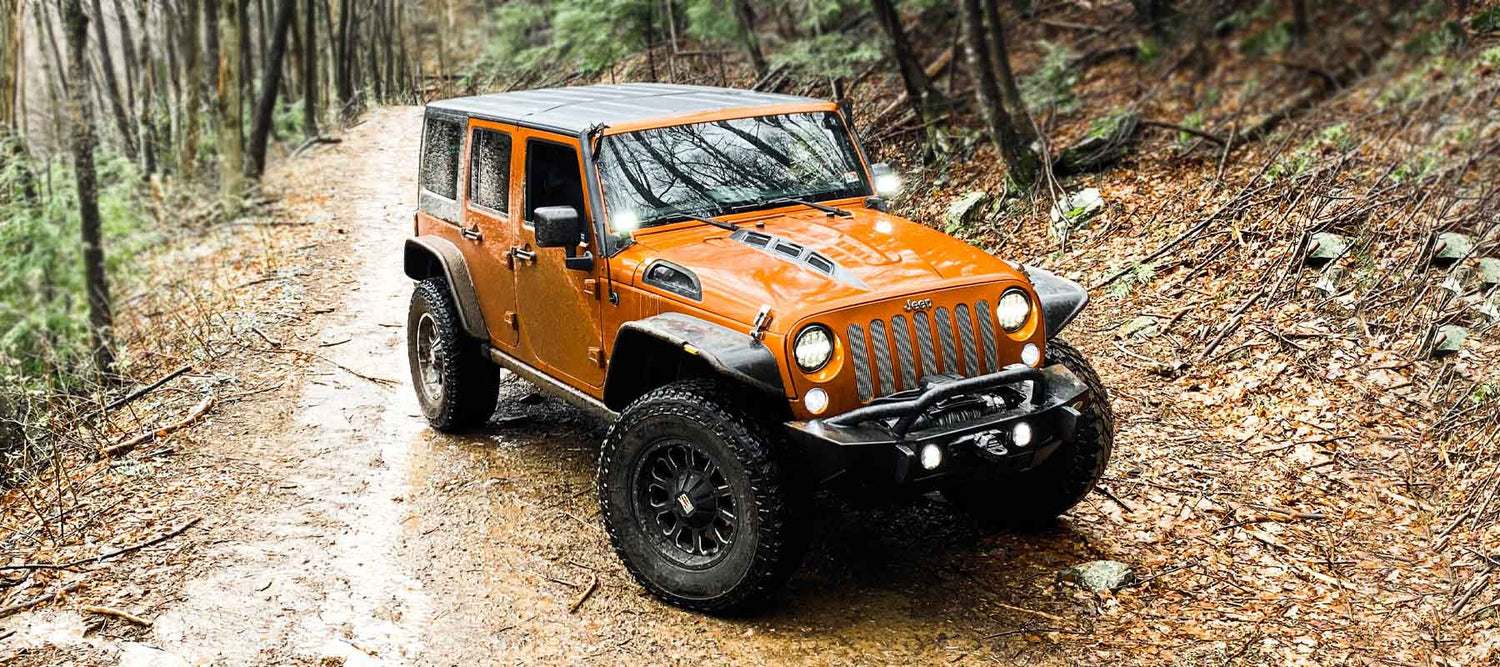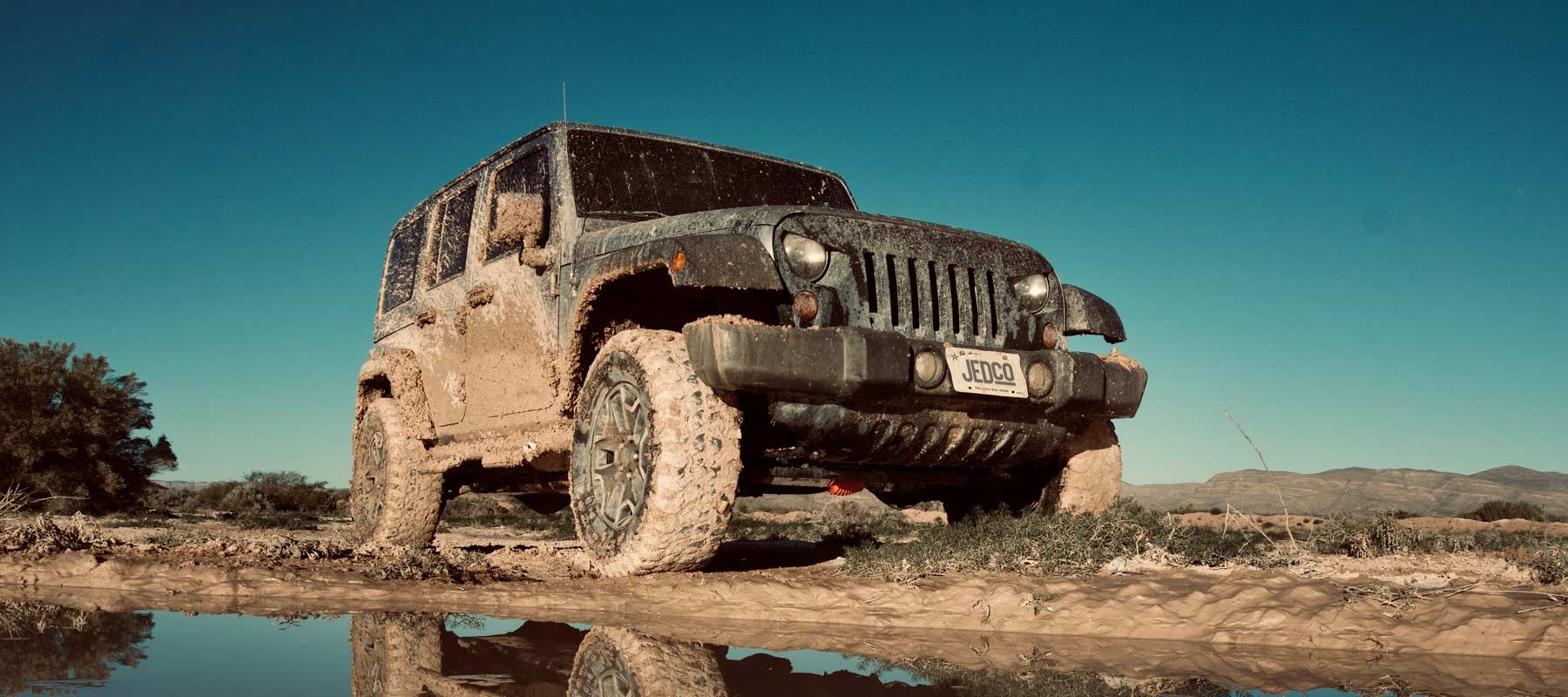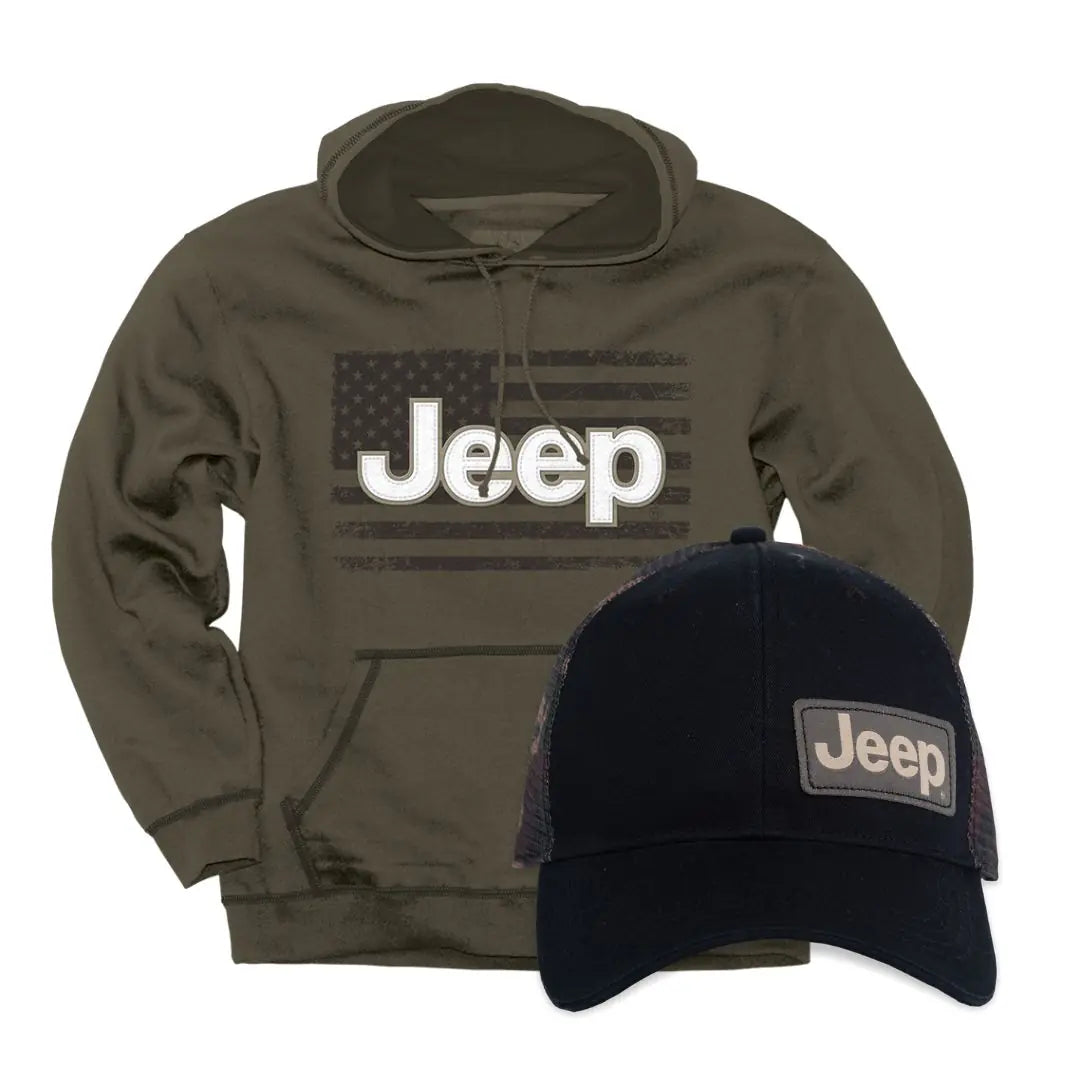If you bought a Jeep Wrangler, chances are you're interested in off-roading. There's something exhilarating about exploring rocky trails where your Wrangler can go and other vehicles can't. However, off-roading can be intimidating for beginners due to safety concerns, clean-up, and lack of experience.
We're here to help you figure out which trails suit your Jeep, how to select the right equipment, and how to adjust to driving in different types of weather. We’ll also provide safety tips and answer your questions. So buckle up and enjoy the ride.
Beginner's Guide to Off-Road Adventures

Before you start planning your first off-road Jeep adventure, you should connect to Jeep outdoor adventure communities.
A great resource before you begin is to check out a trail guide. Many trail guides include trail maps, fun tips, and best practices for off-roading. You can also get key background information and interesting trail history. Your trail guide will give you the necessary context for your off-roading fun.
Finally, be sure to check out these specific websites for guides, tips, and resources:
Figure Out What Types of Off-Roading Trails to Explore

Before you hit the trails, you should determine what types of off-road trails will work best for your Jeep's specific capabilities. You should also think about what kind of off-road trail you will personally enjoy the most.
Your Jeep's Capabilities
Get started by taking a close look at your off-road vehicle. Jeeps have different features depending on model and trim. You have trail-rated Jeeps like the Wrangler, Cherokee Trailhawk, and Gladiator that are best suited for the most rugged trails. But if you don’t have one of those models, fear not: you can invest in add-ons and mods that will be sure to increase off-road performance.
Ultimately, you will have to decide what you want to add based on what trails you want to ride. Will it be rugged terrain? Mountains? Mud? Sand dunes? If so, consider upgrading your Jeep with mods that will keep both you and your Jeep safe and on the go. In a previous article, we’ve laid out the best places to score all the necessary accessories and mods. You might also consider aftermarket door accessories or ARB 4x4 accessories to make your off-road jeep adventures even better.
Or, you could keep your Jeep as-is and limit yourself to trails that work with your vehicle's current capabilities.
Here are some of the features to consider for your Jeep:
- Four-wheel drive system: Part-time 4WD or on-demand 4WD
- Selec-Terrain (Traction Management System): Includes Auto, Snow, Sport, Sand/Mud, and Rock modes
- Quadra-Lift (Suspension) System: Includes off-road settings
- Heated seats and mirrors
- LED headlights
- Antennas
- Lockboxes
Mudding

Jeepers like to play in the mud. Mudding is probably the first activity you think of when you imagine off-roading in a Jeep. Mudding can be a fun way to get up close and personal with mother nature. And, of course, who doesn’t like to coat yourself and your vehicle in mud? It’s great for the skin (but maybe not your Jeep’s body paint).
When you go mudding, don’t get stuck—keep your Jeeps' gears low as you power through those thick mud patches. If you ever feel your vehicle slipping, don’t panic. Instead, try moving your steering wheel back and forth. If that doesn't work, turn off your engine. It's better to stop and turn around than to crash your Jeep and need to get towed out. You’ll have enough to do cleaning the mud from your Jeep without a repair bill to make you think twice about your next mudding adventure.
Rock-Crawling

There's a reason for the name: when you rock crawl in a Jeep, you should practically crawl over those rocks. In other words, you’ll want to go extremely slow. To be safe, you should also let a little bit of air out of your tires. Airing down your tires increases your tire’s surface grip and improves traction. But please do this carefully. You don’t want to lose too much air and risk a flat. Having a portable air compressor will help you re-inflate once you’re off the trail.
Like mudding, you will want your Jeep to be in a low gear. Going too fast over rocks can cause significant damage to your Jeep, so think low and slow. Obviously, some bumps are normal, but if your Jeep is jolting too much, you'll want to slow down.
If you’ve got the cash to invest in some mods, think about the underside: skid plates would be a good idea. The slabs of metal protect the underside of your Jeep, keeping your drivetrain, shock mounts, gas tank, and other vital Jeep parts from damage.
Lighting Trails at Night
If you're planning on off-roading at night, be sure to invest in some good LED headlights to see what you're doing. Another good investment is an LED lightbar. Sometimes you get carried away when you’re blazing down the trail and forget that the sun actually goes down. An LED lightbar will illuminate your way home and will run you from $100 to $1,000 or above. Other lighting options include upgrading to halogen lights. We'd also recommend just waiting until you’re comfortable off-roading during the day before you make a night of it.
Overlanding & Camping
Once you have a bunch of off-roading trips under your belt, you may be ready to try Overlanding. Overlanding, as Car and Driver says, is “vehicle-dependent adventure travel, where the journey is the primary goal.” You can use your Jeep to explore off the beaten path, away from tourist attractions and motels. You use your Jeep as a shelter as you explore places only your 4x4 can take you, camping out in the woods or hard-to-reach desert locales or exclusive mountain enclaves. You can sleep right in your Jeep or invest in a rooftop tent and sleep up high and dry under the stars.
Overlanding is perfect for Jeep owners who are okay with roughing it and living off the land. Overlanding in your Jeep is not that different from standard camping. If you are comfortable with outdoor adventures and want to incorporate your favorite off-road vehicle, Overlanding is an excellent option for an exciting camping adventure
Sand Desert Racing
Sand desert racing involves driving your Jeep through a sand course against another Jeep to see who can complete the course the fastest. It’s one of the most fun and exciting ways to use your Jeep, so let’s go! First, consider whether your Jeep can handle the sand. Certain Jeeps like the Mojave Gladiator are desert-rated, making them the most suitable choice for racing in the desert. Consult with your manual to see if your Jeep has this rating, which includes high test scores for ride control and stability, sand/dirt traction, ground clearance, maneuverability, and desert prowess.
You should be comfortable with your Jeep’s controls and maneuvers before attempting any kind of race, so save sand desert racing for when you have a lot of experience off-roading. If you're interested in trying it, there are plenty of Jeep groups online, so you should be able to find a group dedicated to sand desert racing for tips and tricks and race locations. Your local Jeep club might also provide intel and guidance if you’re interested in becoming a sand racer.
Make Sure You Have The Right Equipment
Certain types of trails will need specific types of equipment, but in general, the following are essential to have on hand in your Jeep at all times when you venture off the main road:
- Air pressure gauge
- Blankets
- Bottled water
- First aid kit
- GPS
- Shovel
- Small toolbox
- Snacks
- Towel
- Tow strap
After you’ve got the essentials, you can outfit your Jeep with seemingly infinite additions and mods. But remember: while it's important to be fully prepared when off-roading, it’s also important not to make your Jeep too heavy.
Learning To Drive in Different Conditions
The different settings you use to drive your Jeep depends on the weather conditions. Here are a couple of general tips for navigating your Jeep in various conditions.
Ice and Snow

When driving your Jeep over ice, be sure to slow down. You don't want your Jeep to spin out. If your car starts to slide, steer into the slide, but don't jerk the wheel.
Instead, turn it very gently. It also will help to utilize that famous four-wheel drive. If you shift into four-wheel drive, you shouldn't have issues with ice, but still, proceed with caution and drive slowly.
Rain
It might seem like a no-brainer, but if rain is in the forecast and you’ve got the top down, be sure to put the soft-top back on your Jeep. You don't want to get soaked as you drive.
If it does start raining, increase your following distance and slow down. Make sure you have plenty of room to stop if the car ahead slams on the brakes. You’ll also want to ensure that your windshield wipers, lights, and brakes are in great shape.
How To Stay Safe On Trail
Staying safe on the trail should be your main priority. Here are some ways to maximize your safety while still having a great time off-roading.
General Safety Tips
First, pack all of the supplies listed above. You’ll want the necessities on hand if you find yourself in a pickle. Second, bring a friend with you. Off-roading is the most fun when you have someone else along for the ride, sure, but it’s also risky going on trails alone. Bringing a buddy ensures you have someone to help you in an emergency.
How To Approach Lateral Incline Obstacles
Lateral or steep incline obstacles can be an annoying part of your off-roading experience because they put you at risk of tipping or rolling your Jeep.
Take a deep breath and approach these obstacles slowly and steadily. Don't be afraid to climb the obstacle with your Jeep head-on, and make sure your wheels do not lift off the ground. If they do, just back up until you are on all fours again.
How To Approach Water Fording
While splashing through a giant puddle of water sounds like great fun, you should always proceed with caution.
Make sure you know exactly how deep the muddy water is before driving through it. You don’t want to get stuck in a murky pond. You might be tempted to speed through the water, but slow and steady is best. It also helps to have a snorkel, which raises the Jeep’s air intake point for cooler and cleaner air and also helps keep water out of your engine.
How To Approach Off-Roading on Snow
There are a few rules of thumb for driving your Jeep through the snow. First, be sure to use four-wheel drive, which will prevent you from slipping and sliding over the trail. If your Jeep has Selec-Terrain, make sure it’s in Snow mode for the best traction and performance.
Second, make sure you have the right tires for optimal grip. Offroading.com has a great article on the best snow tires for your Wrangler.
Third, do not slam on the brakes. Not only can this cause you to slide, but it can cause damage to your Jeep. Again, drive slow and steady through deeper patches of snow.
How To Drive Down a Steep Slope

Always approach a steep drop straight on. Tackling it at an angle could cause your Jeep to flip or roll, and you certainly do not want that. Your brakes will be your best friend as you slowly cruise down the slope. You can also slip it into low gear to make sure your descent is smooth and steady.
Conclusion
We’ve covered all you need to know to get started in your off-road adventure. Find your local off-roading community for trail ideas, best practices, and safety tips. Make sure you practice how to drive on different types of terrain and in different weather so you’re ready for whatever the trail throws at you. And ensure you’ve got the right gear and mods for your particular off-road adventure. But once you’ve got all that covered, you are ready to rip down the trail in your Jeep!
FAQ
Here are a few of the most commonly asked questions regarding off-road Jeep adventures.
How do I prepare my Jeep for going off-road?
Pack your 4-wheel drive Jeep with all the essential equipment and fill up your gas tank. Ensure you've gathered all your trip details and location information so you can make the best decisions. And you’ll want to have researched the trail’s terrain so that you know what you’ll encounter on your adventure. See below for other off-road accessories that will help your Jeep on the trail.
How fast should I drive when on an off-road trail?
Go as slow as possible and as fast as necessary. How fast you can go depends on the conditions and terrain of the trail. If everything is clear, you can sort of cruise. Slow down if you're driving over rocks, water, sand, ice, or other dangerous ground. They call it crawling over rocks for a reason.
How do I clean my Jeep after a muddy off-road adventure?
Try to clean your Jeep as soon as possible after mudding, so the mud does not dry. Spray your Jeep with warm water and clean it off with gentle soap. You might have to use a brush to scrub stubborn mud clumps. Be sure to wash every inch! For advice on how to clean your Jeep soft-top, go here.
What gear do I need for off-roading?
Some essential gear you should always have in your Jeep includes an air pressure gauge, blankets, bottled water, first aid kit, GPS, shovel, small toolbox, snacks, a towel, and a tow strap.
If you’re looking for mods that will help you off-road, the most important is a lift kit, which you need to accommodate bigger tires and to make sure your Jeep can clear those rocks. For a few hundred dollars, you can get a body lift kit to raise your Jeep one to three inches. Or you might spring for more involved suspension lift kits, which can lift your Jeep even higher. These will run you between $4,000 to $10,000. Whichever you choose, a lift kit is a must for any serious off-road adventure. After you’ve lifted your Jeep, you’re ready for a wheel size increase and a tire upgrade. You might get rugged alloy wheels and larger tires to fit your lift and help you crawl those rocks, or snag some mud tires to help your grip in the muck. Check out this handy Motortrend Jeep-specific guide to purchasing the tires that are right for you.
Next you’ll want a winch: if you’re off-roading right, you’re bound to get stuck at least once. A good winch can pull you free and remove any large obstacles blocking your way. Whether you opt for hydraulic or electric, there are many great aftermarket companies, including WARN, Superwinch, and Smittybuilt, which get excellent customer ratings.
Also, invest in good floor mats that are easy to clean and nerf bars for easier access when getting into the Jeep. In addition, getting fender flares for above your tires can help save your car from excess damage from flying debris.
How can I stay safe on the trail?
Be aware of the directions to trailheads to avoid getting lost. You can track with waypoints to monitor your location and progress. And make sure your equipment is good quality and won't break while you are far from home. And as we’ve mentioned above, it doesn’t hurt to bring along a buddy to help you if you get into trouble.
Where should I go off-roading?
That depends on where you live. There are tons of options in every climate. You can go off-roading in forests, deserts, beaches, mountains, and muddy fields. Do some research in your area to find local spots that are great for off-roading. Your local Jeep club will be a great resource to start with this search.
You might also consider going on a special off-roading adventure with Jeep Jamboree USA. They host weekend trips for Jeep owners at some of the most exciting off-roading destinations in America such as the Badlands, Ozarks, Oregon dunes, Death Valley, the Catskills, and Texas Hill Country, among other stunning locations. One of the most notable trips features the 22-mile Rubicon trail, an old Native American footpath that was used by gold rushers to traverse the Sierra Nevada Mountains. This trail was the site of 4x4 pioneer Mark A. Smith’s first off-road jamboree in 1953. The Jeep Rubicon is a tribute to this iconic trail. Each Jamboree is hosted by experienced guides and caters to various off-roading skill levels. Any Jeep with a 4-LO transfer case can participate. So bring your Jeep and get ready to make new friends. Check out this handy event map to stay posted on upcoming dates near you.






